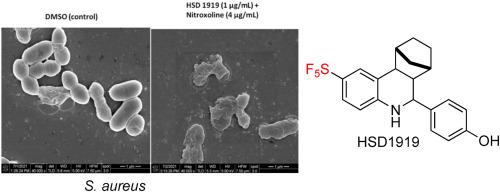European Journal of Medicinal Chemistry ( IF 6.0 ) Pub Date : 2022-06-23 , DOI: 10.1016/j.ejmech.2022.114550 Neetu Dayal 1 , Kenneth I Onyedibe 2 , Whitney M Gribble 1 , Herman O Sintim 2

|
The National Institute of Health (NIH) estimates that the majority of human microbial infections are either linked to or directly caused by bacterial biofilms and these infections are immune to most currently approved FDA drugs. Hence, there is a need for the development of potent antibiotics against biofilms. We have previously shown that pentafluorosulfanyl (SF5)-containing quinoline compounds, which were synthesized via the Povarov reaction, kill persister bacteria (Onyedibe et al. RSC Med Chem, 2021, 12, 1879–1893). Inspired by this earlier discovery, we expanded upon the compounds in the library to identify additional members that could have similar or better potencies, with a goal of increasing the diversity of compounds that could be further developed into therapeutics. Compounds from the Povarov derived SF5-containing compounds inhibited both clinical and laboratory strains of Gram-positive bacteria at minimum inhibitory concentration (MIC) of 0.5 μg/mL to 2 μg/mL. Interestingly, the lead compound, HSD 1919 exhibited rapid bactericidal mode of action against multidrug resistant (MDR) staphylococcal and enterococcal strains such as MRSA and VRE via bacterial membrane disruption. HSD 1919 eradicated persister MRSA in 2 h–8 h. Most remarkably, we found that HSD 1919 (newly identified compound) and HSD 1835 (previously disclosed, Onyedibe et al. RSC Med Chem, 2021, 12, 1879–1893), dispersed preformed MRSA and VRE biofilms at relatively low concentrations (8 μg/mL). Bithionol (at 1 μg/mL) or nitroxoline (at 4 μg/mL) did not appreciably disperse pre-existing biofilms but when combined with HSD 1919 or HSD 1835 (at 0.5–4 μg/mL), preformed MRSA biofilms could be dispersed, highlighting exciting synergy at reasonably low concentrations of the drugs. Biofilm dispersal was verified by scanning electron microscopy (SEM) whilst membrane disruption properties of HSD 1919 were confirmed by both transmission electron microscopy (TEM) and SEM. Further mechanistic studies showed inhibition of DNA, RNA, cell wall and protein synthesis in a macromolecular biosynthesis assay indicating that these compounds inhibit bacteria via multiple mechanisms, which is now being appreciated as an effective way to tackle resistant bacteria. Toxicity studies showed that HSD 1919 was nontoxic in-vitro to mammalian red blood cells at 10X MIC. Herein, we report HSD 1919 and analogs thereof as critical chemical scaffolds, which can be harnessed to develop highly potent antibiofilm therapeutics.
中文翻译:

膜作用 Povarov-Doebner 衍生化合物可有效分散预先形成的耐多药革兰氏阳性细菌生物膜
美国国立卫生研究院 (NIH) 估计,大多数人类微生物感染与细菌生物膜有关或直接由细菌生物膜引起,并且这些感染对大多数目前批准的 FDA 药物免疫。因此,需要开发针对生物膜的有效抗生素。我们之前已经证明,通过 Povarov 反应合成的含有五氟硫烷基 (SF 5 ) 的喹啉化合物可以杀死持久性细菌 (Onyedibe et al. RSC Med Chem, 2021, 12, 1879–1893)。受这一早期发现的启发,我们扩展了库中的化合物,以确定可能具有相似或更好效力的其他成员,目的是增加可进一步开发成治疗药物的化合物的多样性。来自波瓦罗夫衍生的含 SF 5化合物的化合物在 0.5 μg/mL 至 2 μg/mL 的最小抑制浓度 (MIC) 下抑制革兰氏阳性细菌的临床和实验室菌株。有趣的是,先导化合物HSD 1919通过细菌膜破裂对耐多药 (MDR) 葡萄球菌和肠球菌菌株(如 MRSA 和 VRE)表现出快速杀菌作用。HSD 1919在 2 小时至 8 小时内根除持久性 MRSA。最值得注意的是,我们发现HSD 1919(新鉴定的化合物)和HSD 1835(先前披露,Onyedibe 等人RSC Med Chem , 2021, 12, 1879–1893)以相对较低的浓度(8 μg)分散了预先形成的 MRSA 和 VRE生物膜/毫升)。Bithionol(1 μg/mL)或硝唑啉(4 μg/mL)没有明显分散预先存在的生物膜,但当与HSD 1919或HSD 1835(0.5-4 μg/mL)结合时,可以分散预先形成的 MRSA 生物膜,突出了药物在合理低浓度下的令人兴奋的协同作用。生物膜分散通过扫描电子显微镜 (SEM) 验证,而HSD 1919通过透射电子显微镜 (TEM) 和 SEM 得到证实。进一步的机理研究表明,在大分子生物合成测定中,DNA、RNA、细胞壁和蛋白质合成受到抑制,表明这些化合物通过多种机制抑制细菌,现在被认为是解决耐药细菌的有效方法。毒性研究表明,在 10X MIC 下, HSD 1919在体外对哺乳动物红细胞无毒。在此,我们将HSD 1919及其类似物报告为关键的化学支架,可用于开发高效的抗生物膜疗法。











































 京公网安备 11010802027423号
京公网安备 11010802027423号